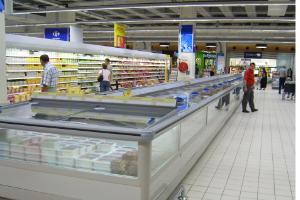 The international chain of hypermarkets of French origin Carrefour, advanced a successful initiative in the store of Bahcelievler, in Turkey, with which it seeks to reduce the emissions of polluting gases to the environment and, in addition, reduce energy consumption through the implementation of a cooling system that uses CO2.
The international chain of hypermarkets of French origin Carrefour, advanced a successful initiative in the store of Bahcelievler, in Turkey, with which it seeks to reduce the emissions of polluting gases to the environment and, in addition, reduce energy consumption through the implementation of a cooling system that uses CO2.by: Santiago Jaramillo H.
The growing interest in reducing the environmental impact derived from its commercial activity, and specifically from that which has to do with the conservation and refrigeration of food has led Carrefour to venture into different initiatives that seek to reduce the levels of emission of toxic gases and, therefore, of ozone depletion.
Given this strong interest, the chain decided to implement in August 2009 the first Subcritical CO2 cooling system in Turkey. Precisely this paper seeks to present the motivation to build in this country the first cascade system, using a natural refrigerant in the Bahcelievler warehouse in Istanbul.
Since its implementation, the use of the CO2-R404a cooling system, resulted in significant reductions in direct emissions compared to HCFC and HFC based systems (exclusively units), as well as a significant decrease in energy consumption, with the consequent economic savings of up to 40%.
Installation and maintenance were carried out at a cost similar to one of HFC's single system. In its ten months of installation, the system has operated with high reliability and safety. The Bahcelievler store has a total area of 7,778 m2 and a constructed area of 12,001 m2 net.
The system chosen by Carrefour supplies the medium temperature (MT) and cooling units of the CO2 condenser with R404a, and the low temperature (LT) with CO2 units (R744). The CO2 rack was designed by the Italian manufacturer Enex, while the installation and tuning was carried out by the Turkish company Cözüm Soğutma.
The installation has a high temperature (HT) frame and a cascade system that brings together the medium (MT) and low (LT) temperature. Since the cascade solution is so dynamic, it was decided to further stabilize the installation with a compressor control for the MT units and an inverter-driven compressor for the LT.
Motivation for change
Technology: From a technical point of view, the cascade system is one of the most consolidated solutions in the commercial refrigeration market. Carbon dioxide has established itself as the preferred cooling carrier fluid for LT units in commercial refrigeration. This component is one of the main candidates to replace the current synthetic refrigerants -both HCFC and HFC-, since it has excellent properties for heat exchange, and has great compatibility with most materials and oils in the facilities.
Manufacturers and component suppliers have gained extensive experience in the design of this type of system, and offer standardized solutions that do not pose any technical problems during installation and maintenance.
Market: The figures differ, but it is estimated that thousands of units of CO2 cascade systems are used in the European Union. The best penetration rate between CO2-only (transcritical) and cascading CO2 systems (subcritical operation) can be found in Denmark (about 100% market penetration), Scandinavia and Switzerland.
Precisely these high rates of introduction in developed countries provide a unique opportunity for developing nations in terms of design, installation, maintenance and the experience already acquired, at lower costs than in the birth of technology.
CO2 as a refrigerant is available worldwide, which means zero restriction for its supply worldwide, as opposed to synthetic fluids.
Similarly, Carrefour representatives claim that market penetration of commercial CO2 refrigeration could be more accelerated if qualified contractors were more available to meet the needs of the CO2 refrigeration market. This is especially relevant for countries outside the European market and more particularly in Latin America.
Environment: The use of natural refrigerants reduces the presence of HCFCs/HFCs throughout the facility, making the system environmentally sustainable. In addition, CO2 occurs naturally, has no ozone depletion potential, nor global warming index.
Costs: Due to the standardization of systems and components for cascade solutions, the cost for design, commissioning, installation and maintenance has been significantly reduced.
A serial production of cascade systems in regions of the world, increased availability of trained personnel, and increased raw material costs for the refrigerant supply (HFC) chemical industry, will reduce upfront costs for CO2 cascade systems.
Similarly, and although a slightly higher initial investment is required (compared to HFC systems), this is offset by energy savings throughout the life cycle of the system.
Carrefour's motivation for investing in cascading CO2 refrigeration systems for food freezing is due to the fact that the prices of these systems have become more accessible and therefore makes sense from the point of view of investment. It also confirms that CO2 cooling helps to minimise your direct greenhouse gas emissions, just as using an energy-efficient coolant you gain stability in terms of energy bills.
So far, ten Carrefour stores in Europe have already been adapted to CO2 refrigeration in France, Belgium, Italy and Turkey.
As for the impact, safety and reliability of the installation, the company highlights that the commissioning and installation was carried out without any major unforeseen events, since the builders and installers foresaw the appropriate precautions for the handling of a high pressure system.
According to Cetinel A.S., the distributor of CO2 compressors in Turkey, HFC systems are still considered to be the most common and well-known alternative to HCFC systems. This leads to a lack of technicians with experience in the installation of CO2 cooling systems in Turkey. However, it confirms that manufacturers are gaining experience in this country, suggesting a more widespread use of this technology in markets outside the European Union, which is currently the strongest market for CO2 systems.













